When do you harvest winter squash?
And how do you cure it for the long winter ahead?
It’s true, the skin color is tempting, though deceptive, because skin color often turns the color of maturity 4+ weeks before maturity is reached— though honeynut, with her built-in ripeness indicator below, is a fabulous exception! She is finally ripe once all the green has turned a deep pumpkin-y caramel color.
Most winter squash skins turn the color of edible maturity well before they are ripe, though honeynut is a marvelous exception, only fully ripe when all green streaks have disappeared.
When to Harvest Winter Squash
Winter squash require ~60 days from pollinated flower to ripe, mature fruit, so here in Zone 5, waiting til mid-September is just a safe bet at the earliest.
We wait as long as possible before frost because, even with powdery mildew often drenching the plants (as below), if there is any green in the leaves & stems that means sugars are being photosynthesized & sent into each fruit.
(Briefly, the best way to prevent powdery mildew is to sow seeds naturally resistant to it, like Cornell’s Bush Delicata, Honeynut and Gouda (a delectable refinement of Long Island Cheese pumpkin!), all the gifts of Cornell’s public plant breeders.)
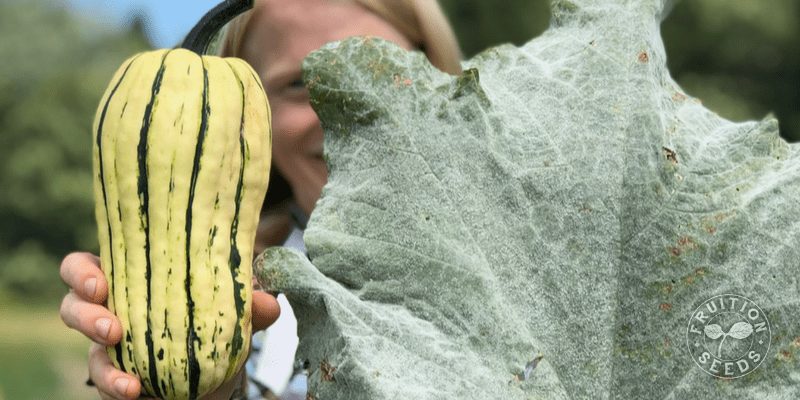
If there is any green in the leaves, even if they’re covered in powdery mildew, keep the fruit on the vine: incredibly, they’ll continue to ripen, deepening in flavor & in storage capacity.
Once your plants are quite thoroughly dead and/or it’s about to frost, we harvest each fruit by snipping each stem 1″ from the fruit, handling them carefully, as if they were marvelously large easter eggs, which I suppose they are!
Harvest all winter squash with snips rather than pulling them from the vine, leaving 1″ of the stem & handling them as delicate eggs. This is Brulee, by the way!
If you’re not able to harvest them before frost, throw old sheets or floating row cover over your fruit to prevent frost from forming on their skin. Frost damages winter squash skin, preventing it from curing which prevents it from storing. Frosted squash is still delicious, just be sure to enjoy it as soon as possible, ideally within one month of frost, with plenty of garlic (if you’re anything like us!). This is true if the stem happens to snap off your fruit or if the skin is punctured even a little, as well.
How to Cure Winter Squash
Very few winter squash are delicious straight from the vine, with delicata (below) being the exquisite exception. The rest are much sweeter & more creamy when ‘cured’ in a warm (80 F is the dream) place with plenty of airflow for at least one week, effectively ‘shrink-wrapping’ as well as deepening their flavor for long-term storage. Your kitchen counter will do a surprisingly excellent job of curing your squash , though a full cure may take several weeks rather than one!
Not all winter squash store equally long. Delicata, above, only store a few months while Sibley and other large maxima varieties often store through the following summer.
Some winter squash only store a short time, like delicata & honeynut; if we enjoy these on New Years, we consider ourselves fortunate. Others are consistently stored through spring & even summer, like Sibley (the hubbard cousin below) who we met sitting resplendent in the center of Patrice Fortier’s dining room table along the northern St. Lawrence in late June. Our Gouda, Cornell’s delectably petite refinement of Long Island Cheese pumpkin (also below), often stores through April.
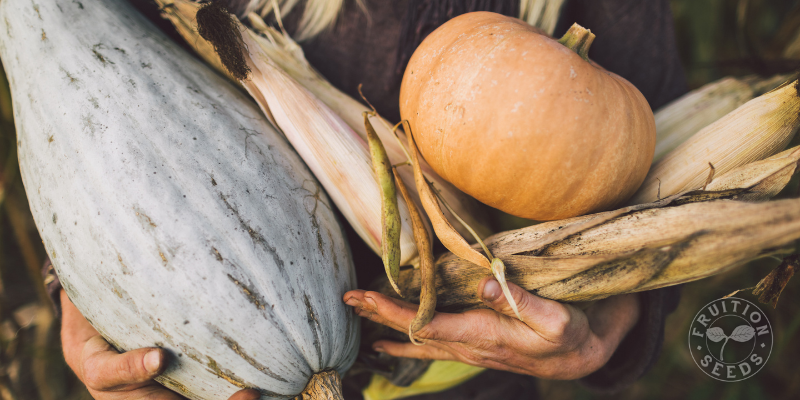
Harvesting Thanksgiving corn, beans and squash in early October!
No matter how careful you are, it’s inevitable that some of your winter squash will store longer than others. Turn your squash every few weeks as they store and enjoy any fruit with soft spots promptly. Savor the deliciously protein-rich seeds as you scoop them out & here is our go-to recipe, among other winter squash insight!
Happy Fall & Happy Harvesting!
Sow Seeds & Sing Songs,

and the Many Beings of Fruition

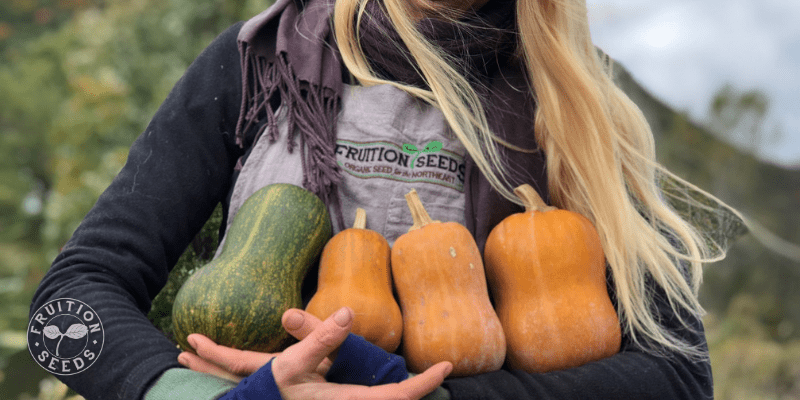
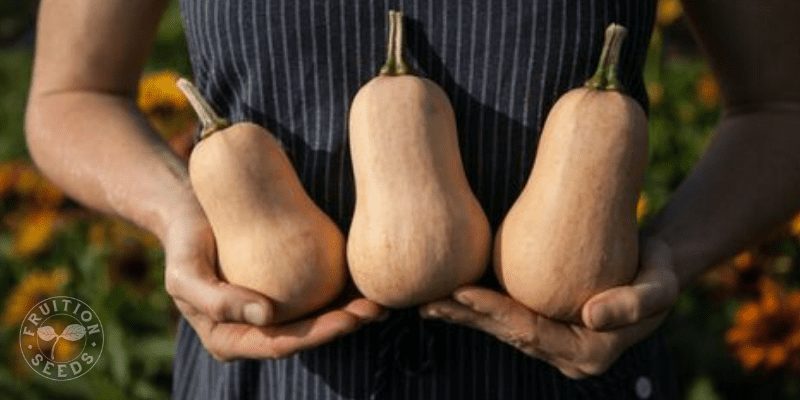
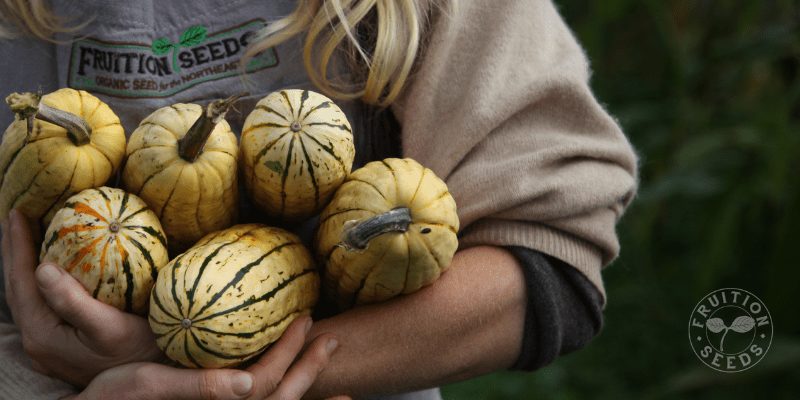
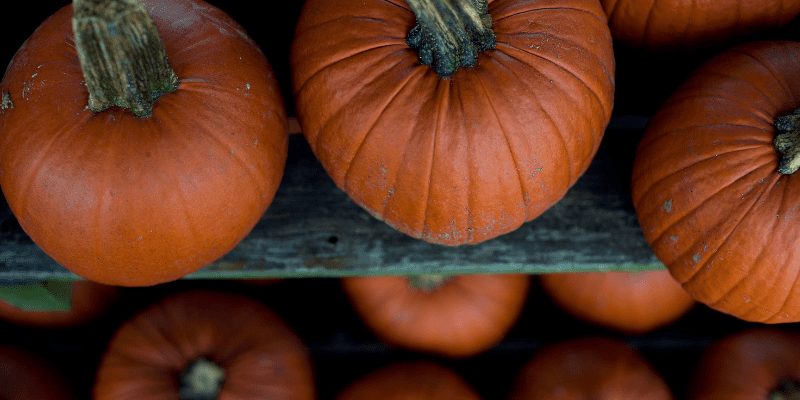
Very good information, thank you kindly, Carol Todd
Thank you Petra for the very informative videos you so generously share! There is always so much to learn and I’ve benefitted from so many of your tips and shared the links with other gardening friends. You make the world of gardening a joyful place that inspires hope for us all. Roasted squash seeds … your method is amazing!
Great information. Any suggestions for spaghetti squash?
HI Fred, Thanks for asking! Our recommendations would be the same for this variety. Melissa <3
How long do you do your 80 degree heat treatment ?
Hi Cindy, we recommend at least a week. Melissa<3
We’re waiting for our HoneyNut Squash to finish ripening before first frost (predicted for end of October here in eastern MA.) Alas, there are many that are still fairly green and almost all leaves have dried up by now. Can we harvest them with some green, and if so, how can we boost them along to full ripening?
Thank you for all your guidance and plant wisdom!
Hi Pam, Thanks for reaching out! WE recommend leaving them on the vine for as long as possible if they are still green. Unfortunately we do not have any tips or tricks to help them ripen past this point. You can try to cure them but using them like you would summer squash would best your best option. Melissa<3
Thanks — we had the same question as Pam’s, as we live in northern Connecticut near the Massachusetts border and some of our musquee de provence pumpkins are still dark green, ugh. (Next year I”ll sow earlier.) So, thank you — we’ll leave them on their powdery vines for now and who knows.